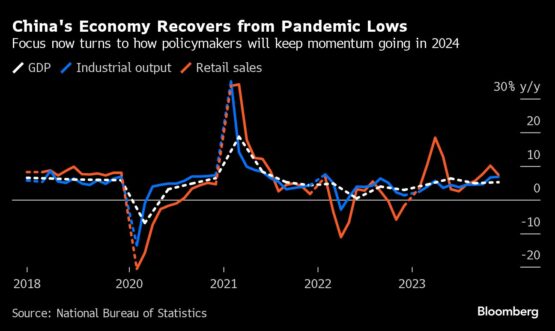China is still contending with major challenges from deflation pressures and the property crisis as the year kicks off, with investors underwhelmed so far by policies to keep economic momentum going.
Data released Wednesday presented a mixed bag for the world’s second-largest economy, which hit an official growth target for the year but has failed to shake off several of the problems most persistently weighing on domestic demand and confidence. A slew of indicators for home prices and property-related spending disappointed, while a measure of broad price changes suggested deflation remains stubborn.
ADVERTISEMENT
CONTINUE READING BELOW
“China’s economic data continues to point at stable consumption and services, but with seemingly never-ending challenges in real estate,” said Gary Ng, senior economist at Natixis SA. “Although the macro picture looks somewhat resilient, it is increasingly a glass half-full or half-empty question for households, corporates and investors in 2024.”
The MSCI China gauge fell while the Hang Seng Index was having its worst day since October as global funds worried about a structural slowdown. The yields on China’s 10-year government bonds have been trading near a two-decade low.
Chinese markets are also tracking a broader selloff in Asia, as expectations for a US rate cut in March get scaled back by recent pushback from Federal Reserve officials. This week’s advance in Treasury yields has spurred declines in emerging markets everywhere.
Gross domestic product grew 5.2% last year, data released by the National Bureau of Statistics showed Wednesday, matching expectations. The fact that rate was in line with Beijing’s official target of “around 5%” was no surprise, though, given Premier Li Qiang revealed the number a day earlier in Davos, Switzerland.
Persistent deflationary pressures and the prolonged property slump proved major challenges through 2023, eventually spurring authorities to roll out more stimulus in the form of rate cuts and fiscal support to help achieve that goal, which was deemed “conservative” when it was announced in March.
Other indicators were mixed in the final month of 2023:
- GDP in the October-December period expanded 5.2% from a year earlier and rose 1% from the previous quarter
- Industrial output rose 6.8% in December from a year ago, compared with a 6.6% increase projected by economists
- Retail sales grew 7.4%, compared with a forecast for an 8% gain
- Fixed-asset investment climbed 3% for the full year, better than a predicted 2.9% rise
- The urban jobless rate was 5.1% last month, up from 5% in November
Deflation pressures
Deflationary pressures aren’t going away, with recent data showing prices dropped in December for a third consecutive month. The GDP deflator — a broad measure of prices — fell 1.5% in the October-to-December period, according to Bloomberg calculations based on official data released Wednesday. That marked a third straight quarter of declines, the gauge’s longest slide since 1999 in the wake of the Asian Financial Crisis.
“Business people care about the amount of money that they earn, and nominal growth is really quite weak,” said Louis Kuijs, chief economist for Asia Pacific at S&P Global Ratings.

Property, population
Another big threat remains the property slump, which has weighed on business investment, undermined job creation and curbed consumer spending. Home prices fell the most since 2015 in December, while spending on construction and decoration fell 7.8% for the entire year compared to 2022, NBS data showed. Housing new starts — a key gauge of confidence among developers — plunged 20.9%.
ADVERTISEMENT
CONTINUE READING BELOW
Other long-term headwinds are looming, too. China’s population extended a historic decline in 2023 as births fell to their lowest on record. A rapidly ageing society would bring further headwinds to the country’s flagging economy, in part by shrinking the size of the workforce that drives growth and funds pension systems.
What Bloomberg Economics Says …
“Soft December activity and the first rise in the jobless rate in five months drove home the message that weakness could extend into 2024 unless policy support is stepped up. The government is already turning up the fiscal throttle — and we expect stronger policy steps, especially on the fiscal side, in coming months. A high base from 2023, though, means it will be tough to drive growth higher this year.” — Chang Shu and David Qu, economists
Stimulus debate
While policymakers have stressed a focus on growth and suggested they’ll increase fiscal support this year, there remains a debate among economists and investors about what exactly that will entail and how large any aid will be.
Li stressed in Davos that last year’s target was reached without resorting to “massive stimulus,” adding that “we did not seek short-term growth while accumulating long-term risk.”
On the monetary policy front, the People’s Bank of China has made use of a lending program to boost property investment and construction. But the central bank has refrained from taking bold steps such as cutting interest rates further — a point reinforced on Monday when it unexpectedly held a key policy rate despite widespread expectations for a reduction.
Fiscal policy is seen driving growth this year, though the size of any increase in spending also remains unclear. China is considering 1 trillion yuan ($139 billion) of new debt issuance under a so-called special sovereign bond plan, only the fourth such sale in the past 26 years, Bloomberg News reported Tuesday.
There’s a way out of the nation’s deflation problem “if they rebalance and use money toward consumption — but size and speed matters,” said Robin Xing, chief China economist at Morgan Stanley. “The longer deflation stays, the bigger policy stimulus is required.”
© 2024 Bloomberg

